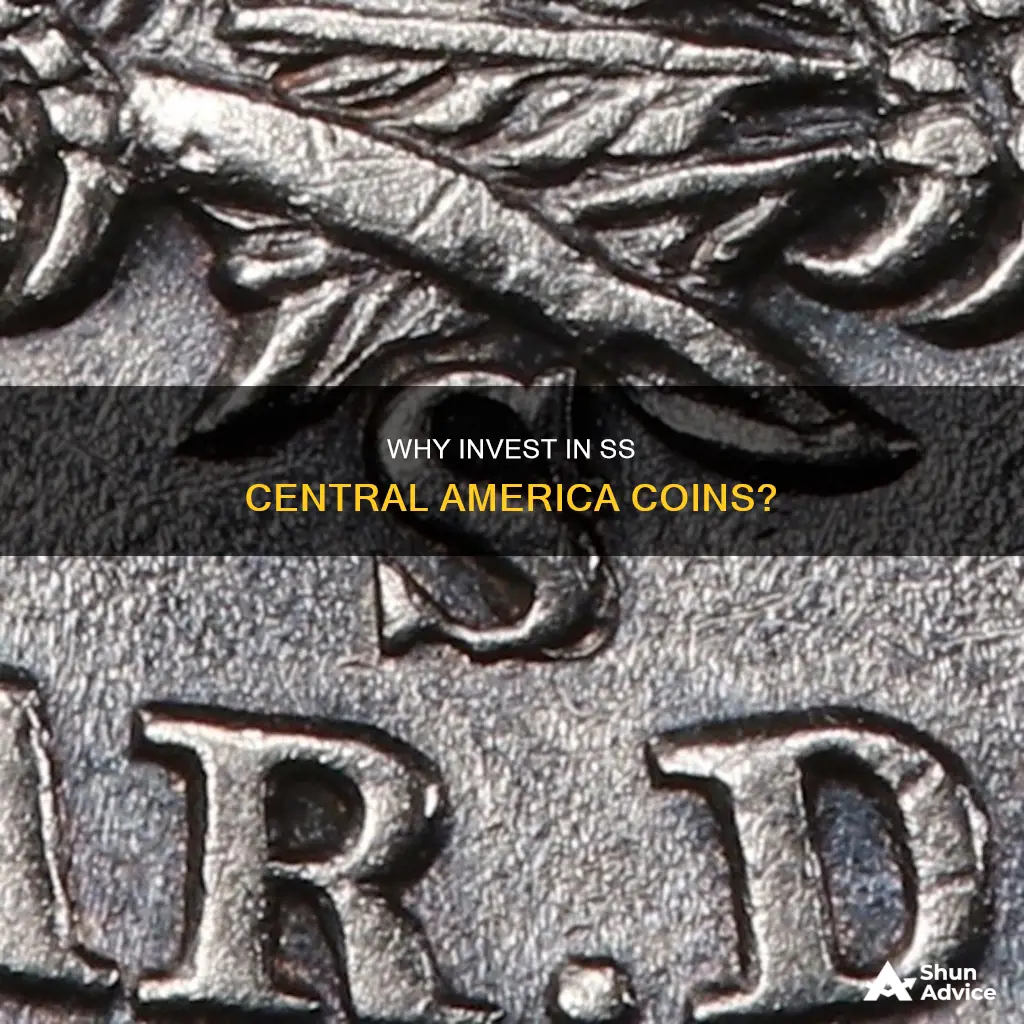
The SS Central America, also known as the Ship of Gold, was a 280-foot sidewheel steamer that operated between Central America and the East Coast of the United States during the 1850s. On September 12, 1857, the ship sank in a hurricane, taking with it 425 lives and over 4,700 pounds of gold from the California Gold Rush. The story of the SS Central America's sinking is a tragic one, and its loss contributed to the Panic of 1857. Today, coins from the shipwreck are sought after by collectors and investors alike. But are they a good investment? In this article, we will explore the history of the SS Central America and the potential benefits and risks of investing in its recovered coins.
| Characteristics | Values |
|---|---|
| Rarity | Coins are rare as they are from a shipwreck and only a few of the thousands of sunken ships have been recovered |
| Historical significance | The SS Central America was involved in the worst ship disaster of its day, causing a financial panic due to the importance of its cargo |
| Demand | SS Central America coins are in very high demand |
| Condition | The coins have been carefully restored by hand and graded by senior graders at PCGS |
| Scarcity | The supply of coins is limited |
| Investment potential | Coins from the SS Central America are a good investment due to their rarity, historical significance, and high demand |
What You'll Learn
- Coins from the SS Central America are rare and desirable to collectors
- The SS Central America was carrying gold from the California Gold Rush
- The ship was discovered in 1988 by a remotely operated vehicle
- The SS Central America's sinking contributed to the Panic of 1857
- The ship's bell was donated to the US Naval Academy in 2021

Coins from the SS Central America are rare and desirable to collectors
The SS Central America left Panama on September 3, 1857, and on September 11, it faced a massive hurricane, eventually crashing while carrying around ten tons of gold coins and bars. The ship claimed the lives of 425 people on board, and all the gold sank to the bottom of the Atlantic Ocean.
The gold was only rediscovered in the 1980s, with a second salvage operation in 2014, and the coins are now highly sought-after by collectors. The SS Central America shipwreck coins are desirable for several reasons. Firstly, they are incredibly rare; of the thousands of ships that have sunk, few are recovered, and even fewer have viable coins aboard. Secondly, they are significant historical artifacts, offering a glimpse into America's past. Finally, many of the coins have retained their original details, luster, and full strikes, making them prized by collectors.
The SS Central America shipwreck coins come from a variety of dates, denominations, metals, and countries. The collection includes coins from Philadelphia, Charlotte, Dahlonega, New Orleans, and San Francisco Mints; various Territorial and Assay coins from the U.S. Assay Office of Gold, Moffat & Co., Kellogg & Co., and Wass, Molitor & Co.; California fractional gold; counterstamped coins from several companies; and foreign coins from Sardinia, Colombia, Costa Rica, France, Great Britain, Nueva Grande, Sweden, Mexico, and others.
The SS Central America coins are a truly rare and desirable collection for any enthusiast or investor.
The Future of Money: Why You Should Invest in Bitcoin
You may want to see also

The SS Central America was carrying gold from the California Gold Rush
The SS Central America, also known as the "Ship of Gold", was a 280-foot sidewheel steamer ship that operated between Central America and the East Coast of the United States during the 1850s. On September 3, 1857, the ship left Panama carrying 101 crew members and 477 passengers, including many gold miners, bound for New York City. The ship was laden with 10 short tons of gold from the California Gold Rush, as well as other precious cargo.
The California Gold Rush began in the late 1840s, attracting people from across the country to the state in search of fortune. The gold would first travel by steamship, then by railroad, before finally being loaded onto the SS Central America to reach its final destination in New York.
On September 9, 1857, the SS Central America was caught in a Category 2 hurricane off the coast of the Carolinas. By September 11, the ship had sustained significant damage, with shredded sails, broken windows, and a failing boiler. Despite the crew's best efforts, the ship continued to take on water, and the rising water level proved too much for the pumps to handle.
The passengers and crew spent the night fighting a losing battle against the rising water. The next morning, two ships were spotted, and only 100 passengers, primarily women and children, were able to be transferred to lifeboats. The ship sank that evening, resulting in the loss of 425 lives.
The sinking of the SS Central America, along with the loss of its valuable cargo, contributed to the Panic of 1857 and led to a severe recession. The ship's cargo included tons of gold from the San Francisco mint, various gold coins, ingots, gold dust, and bullion from the California Gold Rush. Over 7,000 gold coins were recovered from the shipwreck in 1988, and a second batch of coins was made available in the early 2000s.
The SS Central America's story is a fascinating glimpse into the past, and the coins recovered from the shipwreck are highly sought-after by collectors due to their rarity, historical significance, and the rich narrative that accompanies them.
Bitcoin: Investment or Currency?
You may want to see also

The ship was discovered in 1988 by a remotely operated vehicle
The SS Central America, also known as the "Ship of Gold", was a 280-foot (85-metre) sidewheel steamer that operated between Central America and the East Coast of the United States during the 1850s. On September 3, 1857, the ship left Panama carrying 477 passengers and 101 crew members, as well as around 10 tons of gold prospected during the California Gold Rush. On September 9, the ship encountered a Category 2 hurricane off the coast of the Carolinas. Despite the crew's efforts, the ship continued to take on water and sink lower in the water. By September 11, the boiler could no longer be maintained, and the paddle wheels failed, leaving the ship at the mercy of the storm. The SS Central America sank on the evening of September 12, claiming the lives of 425 people.
The ship was discovered in 1988, 130 years after its sinking, by a team led by Tommy Gregory Thompson and using a remotely operated vehicle (ROV). The ROV located the ship 160 miles off the Carolina coast at a depth of 7,200 feet. The discovery of the shipwreck may have been spurred by Harry John, an heir to the Miller Brewing Company fortune who funded treasure hunts through a charitable foundation. Significant amounts of gold and artifacts were recovered and brought to the surface by another ROV built specifically for the operation. The recovered gold was estimated to be worth $100-150 million, including an 80-pound gold bar nicknamed "Eureka" that sold for $8 million.
The SS Central America find is considered a unique time capsule of artifacts from a prosperous and significant time in US history. The ship's sinking has been described as the greatest economic catastrophe in US maritime history, contributing to the Panic of 1857 and a severe recession. The story of the ship's discovery and the subsequent recovery of gold and artifacts has captured the imagination of many, with the coins and other treasures becoming highly sought-after by collectors.
Doge Coin Stock Investment: A Beginner's Guide
You may want to see also

The SS Central America's sinking contributed to the Panic of 1857
The SS Central America, also known as the "Ship of Gold", was a 280-foot (85-metre) sidewheel steamer that operated between Central America and the East Coast of the United States during the 1850s. On its final voyage, it carried 477 passengers, 101 crew members, and around 10 tons of gold, including gold bars and coins, mostly from the California Gold Rush.
On September 3, 1857, the SS Central America left the port of Colon in Panama, sailing for New York. After a stopover in Havana, the ship continued northwards along the US coast. On September 9, it was caught in a Category 2 hurricane off the coast of the Carolinas. By September 11, the ship was taking on water and its boiler had failed. Despite attempts to bail water and restart the boiler, the ship was ultimately engulfed by the relentless waves on September 12, claiming the lives of 425 people.
The loss of the SS Central America had far-reaching consequences and contributed to the Panic of 1857, a worldwide economic depression. The ship's cargo of gold, valued at approximately $2 million in 1857 or $300 million today, was a significant loss that impacted the financial markets. The gold was intended to bolster the reserves of New York banks, which were facing insolvency due to the economic downturn in the region. The loss of this vital cargo further exacerbated the financial hysteria surrounding the banks.
The sinking of the SS Central America highlighted the risks associated with transporting valuable cargo by sea and the potential impact on the economy in the event of a disaster. It also underscored the importance of secure and efficient transportation methods for goods and valuables, especially during times of economic uncertainty.
The story of the SS Central America serves as a reminder of the fragile nature of economic stability and how external factors, such as natural disasters, can trigger widespread financial panic and recession. The loss of life, valuable cargo, and its contribution to the Panic of 1857 make the sinking of the SS Central America a significant event in both maritime and economic history.
The Bitcoin Bet: 50 Cent's Crypto Investment
You may want to see also

The ship's bell was donated to the US Naval Academy in 2021
The SS Central America, also known as the "Ship of Gold", was a 280-foot sidewheel steamer that sank in 1857 while carrying around 15 tons of gold from the California Gold Rush, along with 575-578 passengers and crew members. The ship's commander, William Lewis Herndon, was noted for his heroism in the tragedy, as he sacrificed his life to save 152-153 passengers before going down with the ship.
In 1988, a marine salvage group discovered the wreckage of the SS Central America using a remotely operated underwater vehicle. They recovered an estimated $100 to $150 million worth of gold, along with the ship's bronze bell. The bell, weighing 268 pounds, was eventually acquired by Dwight Manley, a millionaire sports agent and rare coin collector from Brea, California.
Manley purchased the items from the ship in several installments, including gold, personal artifacts, and eventually, the bell. Recognizing the bell's historical significance, Manley decided to donate it to the US Naval Academy in Annapolis, Maryland. The donation was made in August 2021, and the bell was formally dedicated on May 23, 2022, just before the annual Herndon Monument Climb, a tradition for freshmen at the Academy.
The bell now stands near the Herndon Monument, a 21-foot-tall granite obelisk constructed in 1860 to honour Commander Herndon's bravery and sacrifice. The sound of the bell, among the last things Herndon heard as the ship sank, is intended to inspire the next generation of midshipmen with a spirit of fortitude and sacrifice.
The SS Central America bell is a testament to the ship's rich history and the valiant efforts of its commander. Its donation to the US Naval Academy ensures that the memory of those who perished is preserved, and it serves as a reminder of the courage and selflessness exemplified by Commander Herndon.
Coinbase Investment: When to Take the Plunge?
You may want to see also
Frequently asked questions
Coins from the SS Central America are a good investment because they are rare, both in terms of their limited supply and their historical significance. They are also highly desired by collectors due to their retained details, luster, and full strikes.
The SS Central America, also known as the "Ship of Gold", was a 280-foot sidewheel steamer that sank in a hurricane in 1857, taking with it over 425 lives and thousands of pounds of gold. The ship was discovered in 1987, and only a fraction of the coins have been recovered, making them extremely rare and sought-after.
The SS Central America was transporting gold from the California Gold Rush to New York when it sank in a hurricane in September 1857. The loss of the ship's wealth contributed to the Panic of 1857 and a severe recession. The coins recovered from the shipwreck provide a glimpse into this significant time in American history.







